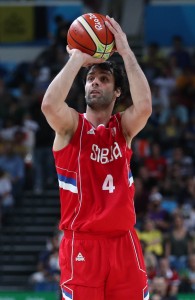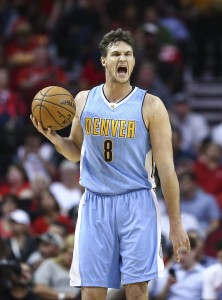JULY 4, 12:25am: The Nuggets are expected to receive some form of draft compensation in the proposed deal – assuming it gets done – for their willingness to facilitate a sign-and-trade of Gallinari, Wojnarowski says in his full ESPN report. It would likely come in the form of a second-round pick from the Hawks, according to Sam Amick of USA Today, who tweets that Atlanta would receive cash in the deal.
JUNE 3, 11:40pm: Crawford has “no plans” to play in Atlanta if this three-way trade gets finalized, so a buyout or another trade of Crawford is considered necessary for the Hawks if they acquire him, tweets Amick.
11:27pm: The proposed sign-and-trade would send Gallinari to the Clippers and Millsap to the Nuggets, with Jamal Crawford, Diamond Stone, and a first-round pick heading to the Hawks, tweets Shams Charania of The Vertical. The first-rounder would likely be the pick L.A. acquired from Houston in last week’s Paul trade, tweets Wojnarowski.
ESPN’s Brian Windhorst suggests (via Twitter) that Crawford may want a buyout if he ends up in Atlanta, though with $14MM+ on his cap hit for 2017/18 and a partial guarantee on his deal for the following year, that could be tricky.
11:16pm: Free agent forward Danilo Gallinari is leaning “strongly” toward committing to sign with the Clippers, league sources tell Adrian Wojnarowski of ESPN (Twitter link). If Gallinari reaches a deal with L.A., it’s expected to be a three-year pact worth $65MM, per Wojnarowski (Twitter link).
According to Sam Amick of USA Today (via Twitter), the Nuggets and Hawks would both be involved in the agreement if Gallinari and the Clippers strike a deal, with the former No. 6 overall pick heading to Los Angeles in a sign-and-trade scenario. The involved parties are still working through the details, but Atlanta would land a first-round pick in the proposed deal, tweets Amick.
The Clippers don’t currently have the cap flexibility to accommodate a market-value Gallinari signing without a sign-and-trade, but the Nuggets won’t be eager to take much – if any – salary back in a sign-and-trade, since they’ve earmarked most of their cap space for Paul Millsap. As such, it makes sense for a team with cap room like the Hawks to enter the mix — they could absorb some outgoing salary from the Clippers, getting a draft pick in the process as a sweetener. And, with Denver involved, they could also include Millsap in the deal.
We’ll wait to see whether the three teams – and Gallinari’s camp – can all come to an agreement, but if the Clippers finalize a deal, they’d be hard-capped for the 2017/18 season at $125.266MM, and would still have their mid-level exception available. Los Angeles shook up its roster last week by trading Chris Paul to the Rockets, but picked up a few interesting pieces in that trade, such as Patrick Beverley, Lou Williams, Montrezl Harrell, and Sam Dekker. The Clips also agreed to re-sign Blake Griffin over the weekend, so there’s still a decent amount of talent on the roster.
Gallinari, who turns 29 next month, has had some trouble staying on the court in recent years, appearing in just 175 total games over the last four seasons. However, he has been a versatile and effective scorer when he plays, averaging 18.2 PPG with a shooting line of .447/.389/.902 in 2016/17.
The Clippers reportedly met with both Gallinari and Rudy Gay over the weekend as the team aggressively sought out a small forward.

